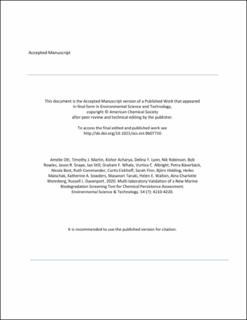| dc.contributor.author | Ott, Amelie | |
| dc.contributor.author | Martin, Timothy J. | |
| dc.contributor.author | Acharya, Kishor | |
| dc.contributor.author | Lyon, Delina Y. | |
| dc.contributor.author | Robinson, Nik | |
| dc.contributor.author | Rowles, Bob | |
| dc.contributor.author | Snape, Jason R. | |
| dc.contributor.author | Still, Ian | |
| dc.contributor.author | Whale, Graham F. | |
| dc.contributor.author | Albright, Vurtice C. | |
| dc.contributor.author | Bäverbäck, Petra | |
| dc.contributor.author | Best, Nicola | |
| dc.contributor.author | Commander, Ruth | |
| dc.contributor.author | Eickhoff, Curtis | |
| dc.contributor.author | Finn, Sarah | |
| dc.contributor.author | Hidding, Björn | |
| dc.contributor.author | Maischak, Heiko | |
| dc.contributor.author | Sowders, Katherine A. | |
| dc.contributor.author | Taruki, Masanori | |
| dc.contributor.author | Walton, Helen E. | |
| dc.contributor.author | Wennberg, Aina Charlotte | |
| dc.contributor.author | Davenport, Russell J. | |
| dc.date.accessioned | 2020-10-27T15:22:11Z | |
| dc.date.available | 2020-10-27T15:22:11Z | |
| dc.date.created | 2020-09-06T21:15:15Z | |
| dc.date.issued | 2020 | |
| dc.identifier.citation | Environmental Science and Technology. 2020, 54 (7), 4210-4220. | en_US |
| dc.identifier.issn | 0013-936X | |
| dc.identifier.uri | https://hdl.handle.net/11250/2685359 | |
| dc.description | Embargo until 12 March 2021 | en_US |
| dc.description.abstract | Current biodegradation screening tests are not specifically designed for persistence assessment of chemicals, often show high inter- and intra-test variability, and often give false negative biodegradation results. Based on previous studies and recommendations, an international ring test involving 13 laboratories validated a new test method for marine biodegradation with a focus on improving the reliability of screening to determine the environmental degradation potential of chemicals. The new method incorporated increased bacterial cell concentrations to better represent the microbial diversity; a chemical is likely to be exposed in the sampled environments and ran beyond 60 days, which is the half-life threshold for chemical persistence in the marine environment. The new test provided a more reliable and less variable characterization of the biodegradation behavior of five reference chemicals (sodium benzoate, triethanolamine, 4-nitrophenol, anionic polyacrylamide, and pentachlorophenol), with respect to REACH and OSPAR persistence thresholds, than the current OECD 306 test. The proposed new method provides a cost-effective screening test for non-persistence that could streamline chemical regulation and reduce the cost and animal welfare implications of further higher tier testing. | en_US |
| dc.language.iso | eng | en_US |
| dc.publisher | American Chemical Society | en_US |
| dc.title | Multi-laboratory validation of a new marine biodegradation screening test for chemical persistence assessment | en_US |
| dc.type | Peer reviewed | en_US |
| dc.type | Journal article | en_US |
| dc.description.version | acceptedVersion | en_US |
| dc.source.pagenumber | 4210-4220 | en_US |
| dc.source.volume | 54 | en_US |
| dc.source.journal | Environmental Science and Technology | en_US |
| dc.source.issue | 7 | en_US |
| dc.identifier.doi | 10.1021/acs.est.9b07710 | |
| dc.identifier.cristin | 1827589 | |
| cristin.ispublished | true | |
| cristin.fulltext | postprint | |
| cristin.qualitycode | 2 | |
